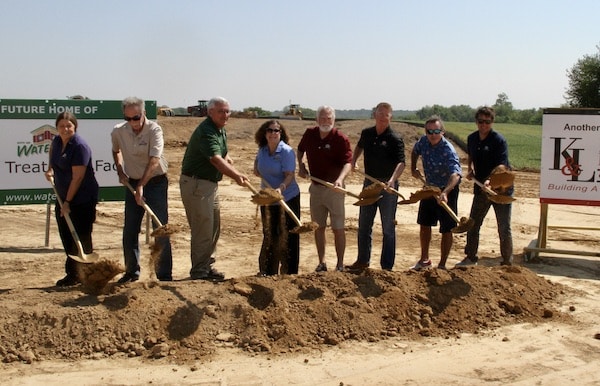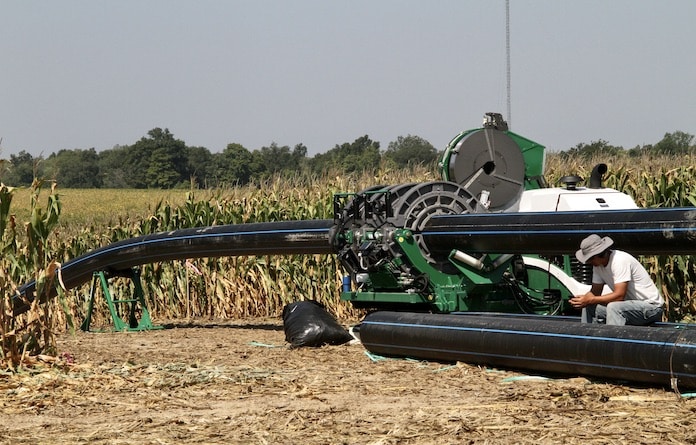Waterloo digs for new water

Work on a new $30 million water plant for the City of Waterloo is underway as city officials joined project managers and others for a groundbreaking ceremony on the project last Wednesday in Valmeyer.
While construction of the water treatment facility takes place, workers can also be seen along Route 156 west of Waterloo heat-welding 50-foot-long water pipe sections into 500-foot-long sections before being placed into the ground.
“We are on schedule,” Waterloo Director of Public Works Tim Birk said of the project. “However, we are laying pipe in farm fields, so a dry fall would help expedite this project. The contractor is fusing about 2,000 feet of pipe per day.”
Waterloo announced plans in February 2019 to build its own facility and leave Illinois American Water, its current provider, at the end of an existing contract that expires in October 2024.
Later that year, Waterloo purchased 9.17 acres of land off East Hunters Ridge just east of Valmeyer for the future site of the treatment facility. The cost of that purchase was $229,250 and included 8,830 feet of easement both west and east of the future plant site for the installment of water line.
In 2021, Waterloo purchased nearly 28 acres of land in the area of 7800 Bluff Road from the Village of Valmeyer for $215,000. This land will serve as the well site for Waterloo’s new water treatment plant.
The water source for Waterloo’s new plant will be the Mississippi Embayment Aquifer System just north of Valmeyer.
Once completed, Waterloo’s new plant will be able to accommodate 3.5 million gallons of water per day.
Presently, Waterloo uses about one million gallons per day.
Also as part of this project, the city is building a new water tower on the Waterloo VFW property.
The existing tower next to Waterloo City Hall has a capacity of 250,000 gallons. The estimated cost of this new water tower, which will have a storage capacity of 500,000 gallons of water, is $2.5 million.
Loan funding for construction of this new plant was reserved through an Illinois Environmental Protection Agency loan with an interest rate of 1.24 percent.
Per an approved city ordinance, the loan for this project will be repaid from revenues of the system, with principal and interest payable semi-annually.
Korte-Luitjohan is serving as general contractor for the water treatment plant, with Haier Plumbing serving as general contractor of the water transmission main and Caldwell Tanks as general contractor of the new water tower.
As for a timetable on this new city water tower, Birk estimated that workers will start digging the footing this fall and complete the tower about this time next year.
Once built and operational, Waterloo’s new water treatment facility will be one of the first pellet softening installations in Illinois as per the Illinois Environmental Protection Agency.
“This technology is used in many other states and in Europe, but just has not been used much in Illinois yet,” explained John Wieter of HMG Engineers, who is engineering the project. “It is the first in Illinois by the supplier Artesian of Pioneer out of Pioneer, Ohio.”
Wieter said the heart of pellet softening installation is the reactor.
“The pellet reactor is a reactor filled with fine-grain sand. Supply water and chemicals (caustic soda, lime wash or sodium carbonate) are injected into the bottom of the reactor and mixed intensively,” he said. “The chemicals increase the pH of the water so that calcium carbonate, lime, leaves the solution and crystallizes on the fine sand in the form of rock-hard balls: the pellets.”
The pellets formed are fluidized by the upward force of the water, he added.
“The pellets gradually grow. This makes them heavier, and the surface of the whole pellet bed becomes smaller. Large pellets also fluidize less well than small ones,” Wieter continued. “In most applications, the pellets grow to about 1 millimeter. Through periodic removal of the large pellets and input of new fine sand, the composition of the pellet bed can be controlled.”







